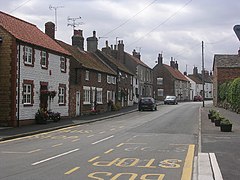Muston, North Yorkshire
| Muston | |
|---|---|
 Muston |
|
| Muston shown within North Yorkshire | |
| Population | 339 (2011 census) |
| OS grid reference | TA096796 |
| • London | 185 mi (298 km) S |
| Civil parish |
|
| District | |
| Shire county | |
| Region | |
| Country | England |
| Sovereign state | United Kingdom |
| Post town | FILEY |
| Postcode district | YO14 |
| Dialling code | 01723 |
| Police | North Yorkshire |
| Fire | North Yorkshire |
| Ambulance | Yorkshire |
| EU Parliament | Yorkshire and the Humber |
| UK Parliament | |
Muston is a village and civil parish, in the Scarborough district of North Yorkshire, England. The village is situated 1.5 miles (2.4 km) south-west from the centre of the coastal town of Filey, and on the A1039 road.
According to the A Dictionary of British Place Names 'Muston' is derived from either the 12th-century "mouse infected farmstead", or a "farmstead of a man called Musi", being an Old Norse person name with the Old English 'tun' (farmstead or enclosure).
Muston is listed in the Domesday Book as "Mustone", in the Torbar Hundred of the East Riding of Yorkshire. The settlement included seven households, twenty-one villagers, six smallholders, and ten ploughlands. In 1066 Karli son of Karli held the Lordship, this transferring in 1086 to Gilbert of Ghent who also became Tenant-in-chief to King William I.
In 1823 Muston was a village and civil parish in the Wapentake of Dickering in the East Riding of Yorkshire. The ecclesiastical parish was a Vicarage held by the Archdeacon of Cleveland, Francis Wrangham. Population at the time was 350. Occupations included fourteen farmers, two butchers, two carpenters, three grocers, a tanner, a bricklayer, a corn miller, a shoemaker, an earthenware dealer, a tailor, a blacksmith, and the landlady of The Cross Keys public house. A daily coach linked Muston to Hull and Scarborough. A carrier operated between the village and Bridlington, Hunmanby and Filey twice weekly.
...
Wikipedia

